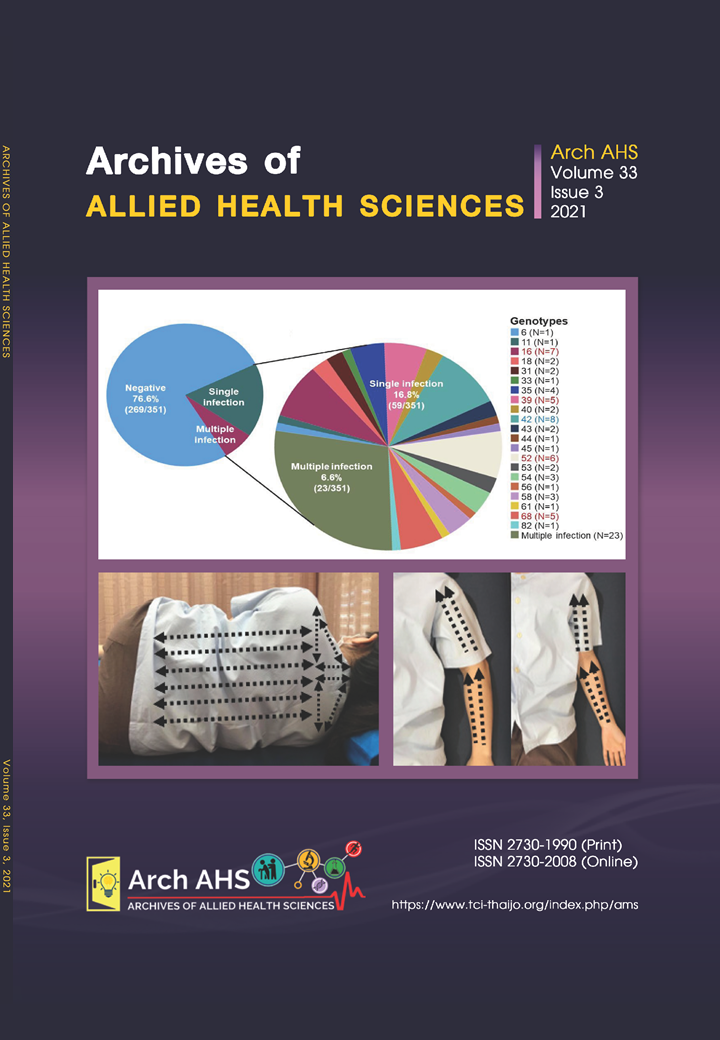Discriminative ability of the Spinal Cord Independence Measure III on levels of independence among ambulatory individuals with spinal cord injury
Main Article Content
Abstract
Spinal Cord Independence Measure ( SCIM) III has been proposed as a test battery to discriminate independence of individuals with spinal cord injury ( SCI) . However, there is no clear evidence to support this claim. This study compared the SCIM III scores among 45 ambulatory individuals with SCI who had different levels of independence. Eligible participants were assessed for their demographics, SCI characteristics, and SCIM III scores (Thai version). The requirement of external assistance and/or devices while completing the tasks of SCIM III were used to categorize the participants into three groups (15 participants/group), including
need assistance, modified independence (MoID) , and independence ( ID). The differences among the groups were compared using the Kruskal-Wallis test. The findings indicated significant differences in the total and subscale SCIM III scores among the three groups (pvalue < 0. 05) , except the respiration and sphincter management between the MoID and ID participants (p-value > 0.05). The current findings clearly confirmed the use of SCIM III scores to discriminate and monitor independence among ambulatory individuals of SCI.
Article Details

This work is licensed under a Creative Commons Attribution-NonCommercial-NoDerivatives 4.0 International License.
References
2. Haisma JA, Bussmann JB, Stam HJ, Sluis TA, Bergen MP, Dallmeijer AJ, et al. Changes in physical capacity during and after inpatient rehabilitation in subjects with a spinal cord injury. Arch Phys Med Rehabil 2006; 87: 741-8.
3. Nas K, Yazmalar L, Abdulkadir A. Rehabilitation of spinal cord injuries. World J Orthop 2015; 18; 6(1): 8-16
4. Sezer N, Akku S, Ugurlu FG F. Chronic complications of spinal cord injury. World J Orthop 2015; 18: 24-33.
5. Jackson AB, Carnel CT, Ditunno JF, Read MS, Boninger ML, Schmerler MR, et al. Outcome measure for gait and ambulation in the spinal cord injury population. J Spinal Cord Med 2008; 31: 487-99.
6. Wannapakhe J, Saensook W, Keawjoho C, Amatachaya S. Reliability and discriminative ability of the spinal cord independence measure III (Thai version). Spinal Cord 2016; 54(3): 213-20.
7. Catz A, Itzkovich M. Spinal cord independence measure: comprehensive ability rating scale for the spinal cord lesion patient. J Rehabil Res Dev 2007; 44: 65-7.
8. Wannapakhe J, Amatachaya S. Correlation between Spinal Cord Independence Measure III (Thai version) and Timed Up and Go Test in patients with incomplete spinal cord injury. J Assoc Med Sci 2016; 50: 229-35
9. Behrman AL, Harkema SJ. Locomotor training after human spinal sord injury: a series of case studies. Phys Ther 2000; 80: 688-700.
10. Quinn TJ, Langhorne P, Stott DJ. Barthel Index for stroke trials development, properties, and application. Stroke 2011; 42: 1146-51.
11. Catz A, Itzkovich M. Spinal Cord Independence Measure: Comprehensive ability rating scale for the spinal cord lesion patient. J Rehabil Res Dev 2007; 44: 65-8.
12. Maynard FM Jr, Bracken MB, Creasey G, Ditunno JF Jr, Donovan WH, Ducker TB, et al. International Standards for Neurological and Functional Classification of Spinal Cord Injury. American Spinal Injury Association. Spinal Cord 1997; 35: 266-74.
13. Unalan H, Misirlioglu TO, Erhan B, Akyuz M, Gunduz B, Irgi E, et al. Validity and reliability study of the Turkish version of Spinal Cord Independence Measure-III. Spinal Cord 2015; 53(6): 455-60.
14. Ackerman P, Morrison SA, McDowell S, Vazquez L. Using the Spinal Cord Independence Measure III to measure functional recovery in a post-acute spinal cord injury program. J Spinal Cord Med 2010; 48: 380-7.


